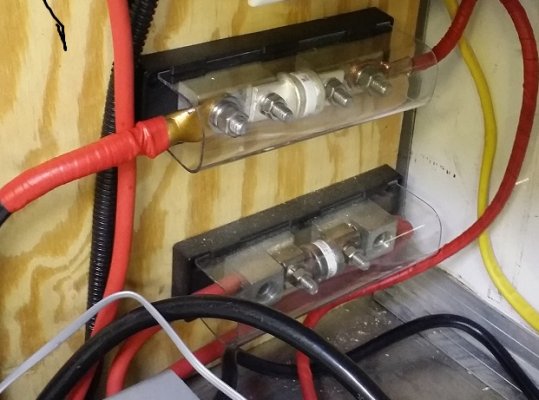Hi all, first time poster.
I've got a Sprinter 2500 cargo van that my dad did a nice conversion job on, building out cabinets and beds, etc., and putting in a rudimentary electrical distribution system (mostly extension cords and power strips for AC, and a DC run to the cooler and FanTastic). The system includes a Xantrex Powerback 1500 as a "house battery" solution. The Xantrex is charged off the 25 amp power outlet in the front of the Sprinter (or by shore charger), and contains an inverter rated at 1350 watts continuous.
At 51 amp hrs, it's a pretty lean boondocking setup.
What I'd like to do is simply replace it with larger batteries and component parts, but leave the system design intact. Meaning, I'd like to buy two kick-ass AGM batteries, find a spot where they can live (where the Xantrex is now, I suspect), and have the same DC charging/small to medium inverter features I currently have. Imagine taking out the three Panasonic batteries that are in the Xantrex now, and hooking up the leads from the larger batts...that's what I'm after.
I'm pretty clear about the inverter, but it's the DC charging that's got me confused...is it as simple as hooking a socket up to the batteries and plugging in the existing DC cable from the front power outlet? If that's a resounding NO, then what do I need?
And, I'd like some sort of digital readout as to the condition/voltage of the batteries, so I'd have a visual reference as to how run-down they were...how would one go about wiring in something like that?
Thanks!
I've got a Sprinter 2500 cargo van that my dad did a nice conversion job on, building out cabinets and beds, etc., and putting in a rudimentary electrical distribution system (mostly extension cords and power strips for AC, and a DC run to the cooler and FanTastic). The system includes a Xantrex Powerback 1500 as a "house battery" solution. The Xantrex is charged off the 25 amp power outlet in the front of the Sprinter (or by shore charger), and contains an inverter rated at 1350 watts continuous.
At 51 amp hrs, it's a pretty lean boondocking setup.
What I'd like to do is simply replace it with larger batteries and component parts, but leave the system design intact. Meaning, I'd like to buy two kick-ass AGM batteries, find a spot where they can live (where the Xantrex is now, I suspect), and have the same DC charging/small to medium inverter features I currently have. Imagine taking out the three Panasonic batteries that are in the Xantrex now, and hooking up the leads from the larger batts...that's what I'm after.
I'm pretty clear about the inverter, but it's the DC charging that's got me confused...is it as simple as hooking a socket up to the batteries and plugging in the existing DC cable from the front power outlet? If that's a resounding NO, then what do I need?
And, I'd like some sort of digital readout as to the condition/voltage of the batteries, so I'd have a visual reference as to how run-down they were...how would one go about wiring in something like that?
Thanks!

